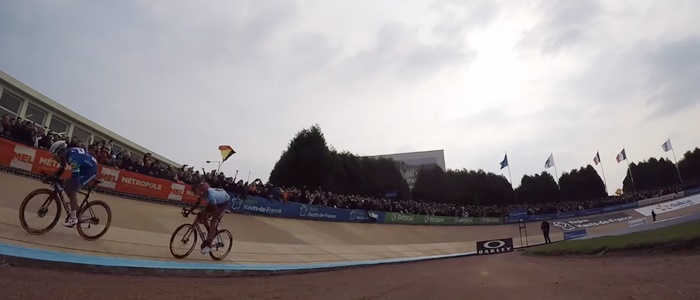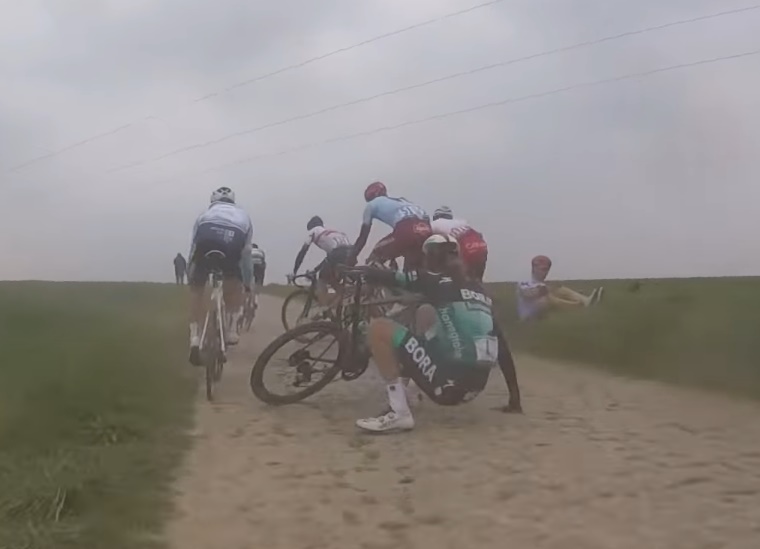
Cycling’s a little like a giant volcano that rises from the seabed. Britons, in particular, see the obvious bit that pokes above the water – the Tour de France and Olympic track cycling – and don’t give much thought to all that lies beneath.
If the other two Grand Tours, the Giro d’Italia and the Vuelta a Espana, are our coastline, then just under the water lie the Monuments – the five big one-day races.
On Sunday it was Paris-Roubaix, which mostly looks like this.

To win Paris-Roubaix, you have to be good enough to be right near the front and you then have to be smart/lucky enough to make your harder efforts at the right moments and, just as importantly, not make them at the wrong moments.
Philippe Gilbert, Phil Gilbert, the rider who effectively dropped the flag on this website, won it. He got to the velodrome where they hold the finish with just one other guy, Nils Politt, and then outsprinted him.
This means that Gilbert has now won four of the five Monuments, plus the other big annual one-day appointment, the World Championships. He is the rider that road cycling nerd Bradley Wiggins perhaps wishes he could have been. And hardly anyone in Britain has heard of him.
Gilbert’s first Monument was the Tour of Lombardy, Il Lombardia, the race of the falling leaves, the autumn one, in 2009.
The Tour of Lombardy is the only Monument with long climbs in it. You win it and people start wondering whether you could maybe do well in the Tour de France. Win it two years in a row, as Gilbert did, and people really start to wonder.
But it’s still a one-day race. You still race to win. There’s no, “finished safely in the main group and retains the overall lead,” rationing of energy here, my son.
One-day racing is Gilbert’s thing. Not for him efficiency. The thing he is best known for is the hard effort uphill – one, two minutes; basically a sprint that goes on long after your legs have ordered you to fucking pack it in.
Gilbert used this unique ability to win another Monument, Liege-Bastogne-Liege, in 2011. Not one to waste good form, he won all three Ardennes Classics that week.
A year later, he became world champion, again thanks to those ferocious uphill thigh pistons.
It was hard to see where he could go from here. Bar stage wins, the Grand Tours hadn’t been his thing and in recent years the ferocity of his surge has started to wane.
Then last year, he won the Tour of Flanders, which it hadn’t massively occurred to people he could do. Crucially, while there are climbs, he won it differently, riding off with 55km to go. The man has stamina these days.
All the same, that was surely his limit. Paris-Roubaix is completely flat after all.
But no, apparently he can win that too.
That leaves Milan-Sanremo as the fifth and final Monument. Can he possibly win that as well?
Milan-Sanremo is a unique race in that it is the only one on the calendar that seemingly everyone can win, from the biggest sprinter to the smallest climber and everyone in between.
So that’s good news. But also, if you think about it, bad news, because he’s not exactly short of rivals.
At the age of 36 Gilbert won’t have too many more chances and many feel he doesn’t have the dynamism to win a race like that any more (he’s been third twice).
But who honestly knows.
What’s next?
The Ardennes Classics. Amstel Gold on Sunday, La Fleche Wallonne on Wednesday and then Liege-Bastogne-Liege on Sunday.
Also a reminder that you can sign up to get these articles by email. This seems to be far and away the most popular way to follow the site.
Leave a Reply